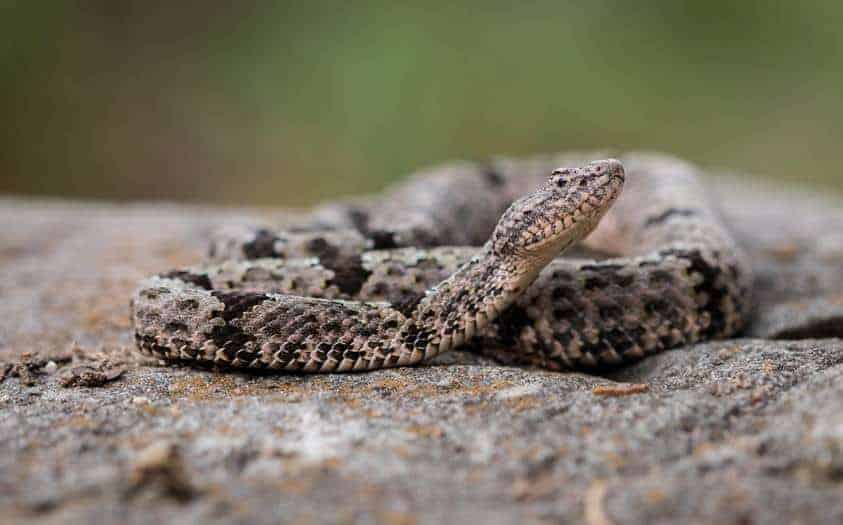Like wine, some snake venom is more complex than others. It all depends on the meal it is paired with.
New research can tell us why. The study shows that evolutionary diversity among prey – say, a combination of mice, turtles and fish – has been the key driver of venom complexity in rattlesnakes, copperheads and other North American pit vipers.
To arrive at this conclusion, researchers added data on the genes and proteins in venom samples to a century’s worth of previous studies of what snakes ate. The team found that a diet consisting of prey with the greatest evolutionary distance between common ancestors was associated with snake venom that contained the widest range of toxins.

Snake venom incapacitates prey by disrupting a variety of physiological processes, attacking the nervous system, blood-clotting capabilities, cell membranes and muscles. So, for example, a snake that eats mammals and amphibians would need venom that could act on the quite different constitutions found in each of those classes of animals.
“A mouse is a mouse is a mouse to a rattlesnake, whereas a mouse and a frog and a lizard are quite different – because of the way that they’re built, their physiology, and the way venom attacks them,” said H. Lisle Gibbs, professor of evolution, ecology and organismal biology at The Ohio State University and a co-author of the study.
The finding suggests that species richness – the number of different species in an ecological community – is not the driving force behind predator trait complexity. Instead, snake venom complexity has evolved in response to the divergence, or how distantly related prey species are, to mirror the divergence of the venom’s physiological targets.
“If we’re going to explain the origins and continued evolution and diversification of life, we need models and rules for what scenarios lead evolution to take one trajectory versus another. Do you become more simple or do you become more complex?” said first author Matthew Holding, a former graduate student in Gibbs’ lab who conducted this work as a postdoctoral researcher at Florida State University and Clemson University.
“We’ve seen the evolution of both more simple and more complex venoms over the past 12-18 million years, and we can now say why, and what drove it.”

Christopher Parkinson, professor of biological sciences at Clemson, is the senior author of the study.
The research is published online today (April 19, 2021) in the journal Proceedings of the National Academy of Sciences.
The study was a massive field-work and computational undertaking, involving capturing snakes in their natural habitats to collect their venom and the analysis of large sets of genetic data and historic ecological information to explore the evolutionary relationships between diet and venom complexity.
“What’s powerful about this study is really being able to link some very disparate dimensions of biodiversity together,” said study co-author Andrew Mason, a former Clemson postdoc who is now a postdoctoral researcher in Gibbs’ lab at Ohio State. “People have this misconception about venom, that it’s just this liquid that hurts you. But it’s tens of different proteins, and every species could have a different combination or set of them. This paper defines a fundamental rule for what governs the evolution of that trait.”
Researchers analyzed biological samples from 169 front-fanged venomous snakes, a group that includes rattlesnakes, cottonmouths and cantils, comparing the protein complexity of the venom itself to the genes that had been expressed in the venom glands. The data analysis allowed the scientists to confirm that what was seen at the genetic level reflected the complexity of venom based on its protein content, and also served as the basis of a new tree of evolutionary relationships for this group of snakes.
The data on snake diets came from previously published studies conducted over the years that examined stomach contents to determine what these snakes ate. The data showed an average of about six different classes of prey and an average divergence of prey species from their shared ancestors of 365 million years.
Adding data from existing evolutionary trees for different types of prey, the researchers produced a united tree representing prey species’ divergence to calculate diet diversity.
“We layered all of this information and produced correlations,” said Holding, now a postdoctoral research fellow at the University of Michigan. “We crunched the data together to find a single number that tells us how much variety there is in the diet of one snake versus another, and this showed the positive relationship between having a complex diet and having complex venom.”
In addition to answering an important evolutionary question, the research has practical implications for humans. The more that is known about venom, the better positioned scientists are to develop anti-venom agents to treat people bitten by snakes. The detailed genetic data gleaned from the snakes could also open up new possibilities for the use of venom proteins as the basis for clot-busting and pain medications.
“That knowledge alone is really valuable from a public health perspective,” Gibbs said. “Many of these snakes have never been characterized in this amount of detail.”
The international team of scientists from the United States, Mexico and Brazil conducting this work is supported in part by a National Science Foundation Dimensions of Biodiversity grant.


